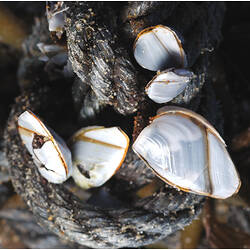General Description
Side plates wide and white at the end of a smooth stalk. Up to 7 cm long.
Biology
Goose Barnacles form dense populations attached to floating object such as oceanic drift wood. Colonies of multiple barnacles can wash ashore, still attached to their floating home. The stranded colony may survive a short time on the beach during which time their specialised feathery feeding legs (cirri) can be seen moving, but they will not last long in this environment. The species differ in the shape of the side plates: some have triangular plates, others have rounded or longer plates. They only survive a short time if washed onto the beach.
Distribution
Worldwide. Southern Australia.
Habitat
Open ocean, attached to floating debris, such as wood. Sometimes found washed up on beaches.
More Information
-
Animal Type
-
Animal SubType
-
Brief Id
A barnacle with five white plates on the end of a stalk.
-
Colours
White
-
Habitats
-
Diet
Plankton or Particles
-
Endemicity
-
Commercial
No
-
Conservation Statuses
CITES: Not listed, FFG Threatened List: Not listed, EPBC Act 1999: Not listed, IUCN Red List: Not listed
-
Depths
Shore (0-1 m)
-
Water Column Locations
Surface
-
Taxon Name
-
Common Name
Goose Barnacle
-
Phylum
-
Subphylum
-
Class
-
Subclass
-
Superorder
-
Order
-
Suborder
-
Family
-
Genus





